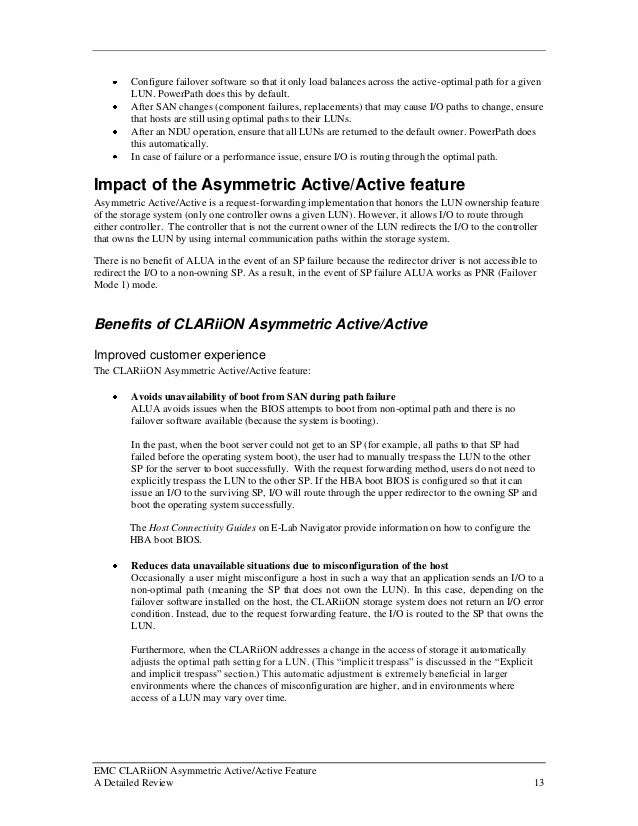How To Install Emc Powerpath On Solaris 11 Documentation
1-2 PowerPath 5.0 for Solaris Installation and Administration Guide Installing PowerPath Before you install The sequence in which you configure the storage and install EMC ® PowerPath® depends on the type of storage system you use: Symmetrix, Hitachi Lightning, HP StorageWorks xp, and IBM ESS systems. Related documentation The following EMC publications provide additional information: EMC PowerPath Installation and Administration Guide EMC PowerPath Encryption with RSA User Guide EMC PowerPath and PowerPath /VE for Windows Installation and Administration Guide EMC PowerPath Family CLI and System Messages Reference. If the correct LUN reconfiguration device removal steps are not followed, the user may be required to follow the steps as documented within this document. In this instance, three EMC PowerPath controlled devices have been removed from a Solaris server via the EMC navicli interface, however, VxVM was.
I have been performing an upgrade for a customer, using Solaris Live Upgrade to go from Solaris 10 update 2 to Solaris 10 update 10 and at the same time upgrade EMC powerpath from [an old version] to version 5.5
I am by no means a powerpath expert, but I am well aware of the issues with upgrading only the one without the other. The process I followed is:

- Live-upgrade Solaris
- Remove (pkgrm) powerpath from the ABE
- Comment out the powerpath dependent file systems in the ABE
- LUactivate and reboot
- Install PowerPath 5.5 P 01 B 2
The install finds the left-over power-path config and asks whether I want to upgrade it. On some of the 5 servers, the old version is PowerPath version 5.2, on others it was still running 4.5, but the result is the same for all of them.
At the end of the pkgadd it tells me the driver was successfully installed (it was) and tells me that no reboot is needed. However when I run powercf or powermt display I get an error stating Device(s) not found
Rebooting did not help. cfgadm looks as expected (Sorry I did not save the output), devfsadm -Cv did not create or remove any device links. The HBAs were linking (confirmed by luxadm -e probe as well as fcinfo hba-port)
format showed only the Solaris native links to the LUNs, with half of them in error state as expected due to them seen via both the avtive and passive path. mpathadm is not active.
After googling around I found a suggestion to look at the output of powermt display options to confirm that clariion management is enabled, and found that is says 'unmanaged'... All other storage classes showed as 'managed'
I then ran powermt manage class=clariion which returned an error stating incompatible initiator information received from the array
Despite this error I then got the emcpower devices and could see everything looking normal in powermt display dev=all. For good measure I followed this by powercf -q; powermt config; powermt save
I then un-commented the entries in /etc/vfstab and rebooted to make sure all was ok. I then ended up with a system in single-suer mode with filesystems/local in maintenance. I discovered with a lot of testing that I had to redo the powermt manage class=clarion procedure after every reboot.
For now I have reverted to the old pre-upgrade ABE. Everything is still working perfectly when I moved back to the old versions of Solaris and PowerPath.
JohanJohan2 Answers
I did the following and it worked:
Although the Solaris OS can distinguish between FC and iSCSI devices, PowerPath 5.5 does not make this distinction for manage and unmanage. The mpxio-disable value must be set to yes in both the fp.conf and iscsi.conf files for PowerPath to manage the following storage arrays:
EMC VNX

EMC CLARiiON
Hitachi USP and HP StorageWorks EVA 3000/5000/8000
Arrays listed in scsi_vhci.conf
See page 35 of the 'Installation and Administration guide' for EMC PowerPath for Solaris for more details. The 'Determine if arrays are managed by PowerPath or MPxIO' chapter provides the details. When 'mpxio-disable=yes' statement is missing from iscsi.conf file, VNX class is implicitly managed by MPxIO. Since there is no explicit statement to manage the class (the VNX class did not exist in the previous release), the new VNX becomes 'unmanaged'.
AnthonIn addition to the /kernel/drv/iscsi.conf mpxio-disable=yes is missing, I also found that the emcpower devices become incorrectly numbered post PP5.5 upgrade and reboot. Luckily I had taken a backup of my mappings prior to the work which I was then able to restore from.
Then save your config:
slm♦Emc Powerpath Download
Not the answer you're looking for? Browse other questions tagged solarisupgrade or ask your own question.
When I run powercf -q on my Solaris machine, what changes does this command do on the EMC storage, or on Solaris file system?
From manual page:
Mat1 Answer
It doesn't make any changes on the EMC storage. It only scans the fibre channel bus to see what world-wide names are visible through each local port. If it sees the same WWN through multiple ports, then it sets that storage device up for multipath I/O.
Changes are made to emcp.conf in /kernel/drv, and those changes in turn effect how device paths are created under /devices and/or /dev.
If you're on a Solaris system with a zfs root, you can install fresh, snapshot the system, then install PowerPath, run powercf -q, and do a zfs diff rpool/ROOT/solaris@snapshot rpool/ROOT/solaris to see exactly what changed in your root filesystem.

If you don't have zfs root, you could always install a system, let it sit for 30 minutes, then run powercf -q, then use find / -mmin -30 to find files younger than 30 minutes.